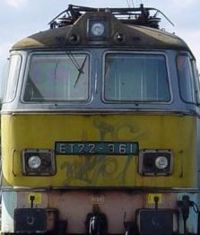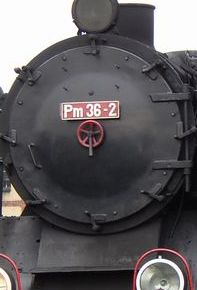PKP classification system
PKP classification system (Polish locomotive designation) is a system of devoting numbers to series and individual locomotives used by the PKP - Polish railroad operator.
The system was introduced in 1923, shortly after regaining independence of Poland (1918), when the Polish railroads inherited a whole range of former German, Austrian and Russian steam locomotives and there appeared a need of names' unification. The result was a logical system, by which one can tell a locomotive type (passenger/freight), wheel arrangement, origin and some other information. After the World War II a similar system was also adapted for diesel and electric locomotives.
Contents
Electric and diesel locomotives

First letter
- E - electric locomotive (Pl. elektryczna)
- S - diesel locomotive (Pl. spalinowa)
Second letter
Locomotives:
- P - passenger locomotive (Pl. pasażerska)
- T - freight locomotive (Pl. towarowa)
- U - mixed-traffic locomotive (Pl. uniwersalna - universal)
- M - shunting locomotive (Pl. manewrowa)
Electric multiple units:
- W - for high platforms (Pl. wysoki)
- N - for both high and low platforms
- D - for long distances
- A - railbus (Pl. autobus szynowy)
Numbers
Electric locomotives
- 01-14 - four axles, Bo-Bo, direct current, 3 kV
- 15-19 - four axles, Bo-Bo, alternating current
- 20-34 - six axles, Co-Co, direct current, 3 kV
- 35-39 - six axles, Co-Co, alternating current
- 40-49 - different axles set and current
Electric multiple units:
- 51-64 - three car sets, direct current, 3 kV
- 65-69 - three car sets, alternating current
- 70-74 - four car sets, direct current, 3 kV
- 75-79 - four car sets, alternating current
- 80-89 - single electric car, any current
- 90-93 - two car sets, direct current, 800 V
- 94-99 - any car sets, direct different from lower numbers
Diesel locomotives
- 01-09 - mechanical transmission, single steering
- 10-14 - mechanical transmission, multiple steering
- 15-24 - hydraulic transmission, single steering
- 25-29 - hydraulic transmission, multiple steering
- 30-39 - electric transmission, single steering
- 40-49 - electric transmission, multiple steering
Steam locomotives

First letter
- P - fast train locomotive (Pl. pospieszna)
- O - mixed traffic (Pl. osobowa - passenger)
- T - freight locomotive (Pl. towarowa)
Second letter
Second small letter indicates a wheel arrangement, in increasing order, according to a number of driving axles.
- a - one driving axle, any number of unpowered axles
- b - 0-4-0
- c - 2-4-0 or 0-4-2
- d - 4-4-0 or 0-4-4
- e - 2-4-2
- f - 4-4-2 or 2-4-4
- g - two driving axles, more than three unpowered axles,
- h - 0-6-0
- i - 2-6-0 or 0-6-2
- k - 4-6-0 or 0-6-4
- l - 2-6-2
- m - 4-6-2
- n - 2-6-4
- o - three driving axles, more than three unpowered axles
- p - 0-8-0
- r - 2-8-0 or 0-8-2
- s - 4-8-0 or 0-8-4
- t - 2-8-2
- u - four driving axles, more than two unpowered axles
- w - 0-10-0
- y - 2-10-0
- z - five driving axles, more than one unpowered axle
- x - narrow gauge, all axle arrangements ("x" also could mean six driving axles, but such locomotives were not used in Poland)
Number
- 1-9 - German production steam engine
- 10-19 - Austrian production steam engine
- 20-99 - Polish production steam engine, number stood for the last two digits of year of adoption
- 100-199 - Other foreign production steam engine, brought for PKP between 1918 and 1939
- 200-299 - Other foreign production steam engine, brought for PKP after 1945
Additional K letter
Additional K letter between the previous two meant that the locomotive was a tank engine, and didn't have its own tender (for example TKt48).
Serial numbers
Following the letters and numbers already described, the serial number of the individual locomotive is stated. This consists of several digits and is separated from the previous characters by a dash. In the case of electric and diesel locomotives consisting of two cars, the letters A and B were added after the serial number for each car.
Tenders
First number
- First number of tender classification described water capacity in m3
Letter
- Letter included in the middle of classification described number of axles, ie:
- C - three axles
- D - four axles
Second number
- A number included after the letter describing axles referred to the year of construction, so number 23 says the construction was approved in 1923.
An example
A tender numbered 22D23 can carry up to 22 m3 of water, has four axles, and its construction was approved in 1923.
See also
| Locomotives of Polskie Koleje Państwowe: | |
|---|---|
| Diesel locomotives: | SM03 | SM04 | SM30 | SM31 | SM40 | SM41 | SM42 | SM48 | SP32 | SP42 | SP45 | SP47 | ST43 | ST44 SU42 | SU45 | SU46 |
| Electric locomotives: | EM10 | EP02 | EP03 | EP05 | EP07 | EP08 | EP09 | ET21 | ET22 | ET40 | ET41 | ET42 | EU04 | EU05 | EU06 | EU07 |
| Steam locomotives: | Ok1 | Ok22 | OKl27 | Ol49 | Pm36 | Pt31 | Pt47 | Pu29 | TKt48 | Ty2 | Ty45 | Ty51 |
| Multiple units of Polskie Koleje Państwowe: | |
| Electric multiple units: | ED72 | ED73 | EN57 | EN71 |
| Diesel multiple units: | SN61 | SN81 | SA101 | SA102 | SA103 | SA104 | SA105 | SA106 | SA107 | SA108 | SA109 | SA110 | SA131 | SA132 | SA133 |
